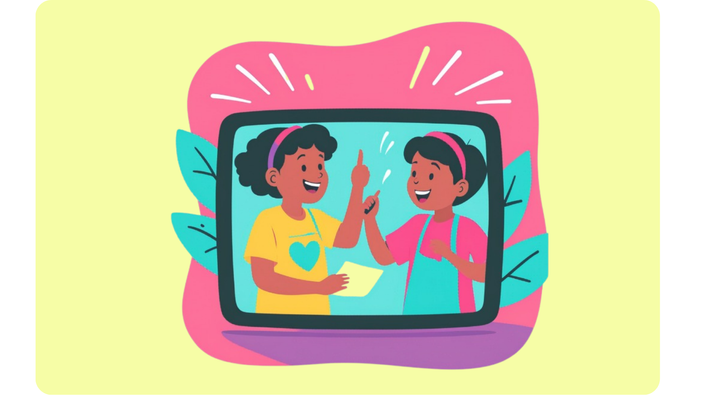A Gen Z Teacher’s Perspective on Banning Phones in Schools
Finding the right balance of tech in the classroom can boost student engagement and learning. So should students be allowed to use cellphones in school? Here's a Gen Z teacher's take on how phones in the classroom can be good, bad, and everything in between.

Right up until I joined Kapwing, I was a Gen Z high school teacher. There aren’t many Gen Z educators; apparently, our generation is not that interested in joining the teaching force. My recent students were only 8 years younger than me. Because of my age and teacher status, my perspectives on technology often diverged from those I heard from students and other adults.
Parents, teachers, and administrators today are becoming more and more concerned about the effects of social media and technology on kids. You also don’t have to look far for narratives from teachers about the negative impact of phone use in class. And like many others, the school I worked for most recently is considering implementing a cell phone ban. A recent survey by the NEA (National Education Association) reported that 90% of their nearly 3,000 responding teachers “support policies prohibiting the use of cellphones or other personal devices at school during instructional time” (Heubeck, 2024)
As a group, Gen Z teachers have deep empathy for the way phones both provide comfort and steal attention from our pupils. We also see the perspectives of our frustrated colleagues, who decry the wave of devices overtaking the learning environment.
From no-tech weeks to Instagram assignments, the role of tech has varied widely in my teaching, even in my few years of experience. Throughout my teaching career, I’ve developed some strong opinions about technology, especially the use of phones in the classroom. If you're a teacher or an administrator weighing whether to ban phones, there's much to consider. This article aims to help you think through some major pros and cons.
Here’s where I stand today on phone bans in schools:

Removing phones is disorienting for "digitally native" students and teachers.
“Will someone grab a photo of the board and forward it to the class group chat?”
“Can you call the group outside to bring them in?”
“Wait, voice record this real quick, cause you’ll probably want to play it back later. I’m about to give you some research tips I think will help.”
I’ve said phrases like these again and again in my classroom. The way I lecture, design work, and ask questions in class assumes the presence of phones. Since most people in my life constantly have one, I behave like phones are a strange appendage we’ve added to the human body. My students respond automatically and comfortably. They create reminders and notes for later. They make music videos with their classmates about mitosis. For them, using their phone is as easy as breathing. It’s not that everyone has their phone at every moment, but there are generally a few we can use, just like pens, calculators, or notebooks.
When I remove tech from my classroom, the students and I are left stumbling. I am suddenly printing out hundreds of sheets of paper, and we're all frustrated that we can’t look up new information mid-class. It feels like I’ve asked us to learn with our eyes closed: certainly possible, weirdly intimate, and definitely interesting, but hardly representative of our day-to-day experience.
I don’t know if it’s good or bad to view your phone as an extension of yourself. I do know it’s disorienting to remove this tool from Gen Z. For this generation, phones are an intuitive mode of sensing, acting, and communicating.

Phones can be tools of creation and collaboration in the classroom.
Just as it feels obvious that the basic operations on phones will come naturally to my students, I assume that I can rapidly introduce my classes to cool new apps and tech tools.
Examples of this in my science classroom include things like Merlin Bird ID, allowing students to identify birds by song; Seek by iNaturalist (which uses phone cameras to identify plants and animals) or the real iNaturalist page; and video editors like Kapwing, which allow students to easily create video projects.
How to Identify Birds - Part 1 - Outdoor Creation Experiences
How to Make an Observation on iNaturalist using our Mobile App
Kapwing Hacks - How to Edit Videos FAST
I’m constantly amazed by my students’ effortless adoption of new technologies. They pick up a new app, experiment with the interface for ten minutes, and suddenly they are competent users. They also push tools to do new things and use them creatively. Sometimes, I introduce an app for one purpose, and a student discovers another feature that adds immense value to the lesson and becomes our main way of using the tool. Technology keeps me and my students on our toes and ensures that my curriculum remains on the front edge of educational practice.

The distractive power of the internet is overwhelming.
Though I see the value of phones in class, I also see the downsides. Those cool apps and tools, along with the swamp of dopamine that is social media, take students away from the classroom environment.
Students aren’t with you and each other when they’re online – they’re in a different, liminal space. If people physically disappeared from the room when they got on the internet, most high school classrooms today would like like badly glitching TV screens, with students blinking in and out over and over. Their brains are trying to be in two places at once.
The power of algorithmic feeds adds to the issue. I’ve listened to many teachers talk about the feeling that we have to be more entertaining, more animated, and switch activities faster in the last few years, just to maintain student engagement. How can we compete with the algorithms of an app like TikTok? I don’t track student's attention second by second, I don't adapt to each student in the room effortlessly, and I don’t feed students literally any information that will keep their attention. I cannot psychologically affect them every moment in the way their phones can, and it’s exhausting to try.

It’s deeper than one device.
Phones heighten the problem of distracting content by providing a discrete, miniature access point to the internet that is also viewed as separate from school-related work. Even if students are accessing exactly the same page they would be looking at on a Chromebook or laptop, their phones are a tool we’ve societally decided is casual and personal, not productive. Students treat phone time as “fun” time accordingly.
However, it’s important to recognize that removing phones does not remove distractions in the classroom. You only have to sit in the back of a college lecture hall for a few minutes to see distraction happen on other devices. Students on laptops regularly have hundreds of tabs open and shuffle between taking notes, playing games, online shopping, messaging friends, and Googling school-related (or unrelated) questions.
Most messaging is now cloud-based, and almost anything you can do on a phone, you can do on a laptop. Students might not resist a request to give up a phone in class because they know that the real engagement they’re seeking (the internet) is still available.

Bans are a quick fix, but it’s time to think bigger.
Setting a cell phone ban in your classroom or school might help students socialize with their classmates, reduce their distraction during class, and bring together your school community. It’s certainly worth a try, though you may be giving up some tools and resources that could benefit student learning.
However, I think we’re at a tipping point for considering technology in the classroom more broadly. Schools historically were a source of facts and information about a range of subjects, and there were few sources for that knowledge elsewhere. Committing information to memory meant using your brain in ways that grew your problem-solving and concentration skills. Now, however, nearly all of human knowledge is accessible with the click of a button.
Students today need to develop their minds in new ways, and that requires different processes than just consuming content. The internet is fundamentally shifting our cognitive capacities. We need to decide whether our priority is teaching students to access information in a world where knowledge is easy to get, or whether we prefer to emphasize their social development, cognitive abilities, and “analog” problem-solving skills to mimic previous educational impacts on the mind. Different educators may come to different conclusions on this. The former practice calls for learning to live with phones in the classroom – the latter advocates for their removal.
My recommendation: find a balance.
Phones in classrooms are a double-edged sword. They offer valuable tools for creation, collaboration, and real-time learning that reflect the digital lives our students lead, but they also introduce distractions and pull students out of community.
The path forward doesn't have to be one-size-fits-all. You might strike a balance in your classroom by setting clear boundaries around when and how phones can be used, which could be never or most days depending on your lessons. I led a semester-long class recently where every other class was “device-free,” including laptops (except for accessibility purposes). While this occasionally led to challenges, my students were pretty on board with our completely “tech-free days.” I loved getting students both hands-on experience with tech and distraction-free learning throughout the term.
By creating structured opportunities for both technology integration and internet-free learning, we can teach students how to use their phones responsibly. We need to prepare our students for a future where they are not just passive consumers but active, intentional participants in their digital and physical worlds. Ultimately, the goal isn’t to banish technology or to let it run rampant in our places of learning. We’re going to have to find a middle ground that supports our educational values and prepares students for the realities of a tech-driven world.









